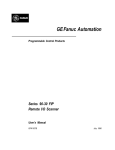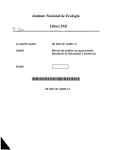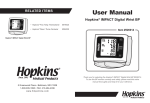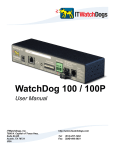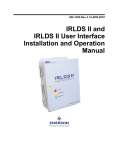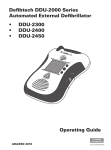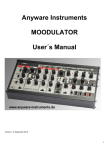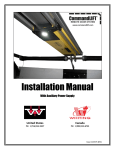Download DiCromat II User`s Manual
Transcript
DICROMAT II & IIA SALT ANALYZERS USER’S MANUAL The Noramar Company P.O. Box 771 Chagrin Falls, OH 44022-0771 Phone: (440) 338-5740 Fax: (440) 247-3879 Note: DiCromat II, DiCromat IIA, and Noramar are trademarks of the Noramar Company. DiCromat II & IIA User's Manual* Table of Contents................................................................................................................................................... Page I. II. III. IV. V. VI. VII. VIII. IX. X. General Description............................................................................................................. 2 Installation........................................................................................................................... 2 • Unpacking ............................................................................................................... 2 • Power-On ................................................................................................................ 3 Operation............................................................................................................................. 3 • General .................................................................................................................... 3 • Initialization Mode .................................................................................................. 4 • Calibration Mode..................................................................................................... 5 • Run Mode................................................................................................................ 8 Probes ................................................................................................................................ 10 • Dip-In .................................................................................................................... 10 • Flow-Through........................................................................................................ 11 Sample Preparation and Titration Procedures ................................................................... 11 • Recommended Procedures .................................................................................... 11 • Titration Procedure................................................................................................ 13 Care and Maintenance ....................................................................................................... 14 Troubleshooting ................................................................................................................ 14 Optional Printer Hook-Up................................................................................................. 15 • Back Panel Configuration ..................................................................................... 15 Appendix ........................................................................................................................... 16 • Quick Start Card Facsimile ............................................................................. 16, 17 • Parts Order Information......................................................................................... 18 • Information for the User-FCC Compliance Statement.......................................... 18 Glossary....................................................................................................................... 19, 20 *DiCromat II is the six (6) set-point model, while DiCromat IIA is the twenty-four (24) set-point model. In all other respects, the instruments are identical. 1 I. General Description The DiCromat II Salt Analyzer measures and displays salt content in solutions by measuring solution conductance and temperature. An internal microprocessor mathematically compensates for changes in solution temperature and converts to salt concentration in various units. A full range of salt concentration can be measured from less than 0.1% to over 26% by weight without dilution and up to 100% salt with dilution. Compensation for temperatures ranging from 0 °C to 100 °C is automatic. A two-line, 16-character-per-line, alpha-numeric display is used to present data and for user prompts to assist in calibration and use of the instrument. This display allows for easy visual identification of the product being tested. Several different probe types may be used with the DiCromat II. The primary probes available from The Noramar Company include a flow-through contact probe or a dip-in non-contact probe. Different probes are accommodated without electrical or mechanical changes to the instrument. Data may be stored internally for six different products. An RS-232C digital output is provided for connecting to a serial printer or computer. The data rate is fixed at 300 Baud. The connection is through the 25-pin D connector on the rear of the instrument. A 0 to 10V DC analog output signal is provided through a two-conductor connector on the rear of the instrument. II. Installation UNPACKING Upon arrival, the shipping boxes for the DiCromat II should include one each of the following items for each unit ordered: • • • • DiCromat II Salt Analyzer User’s Manual The probe of your choice as selected at time of order (either the flow-through contact probe or the dip-in non-contact probe) Quick Start Card Should any item be damaged in shipment, please notify The Noramar Company, 8501 Kinsman Road, Novelty, OH 44072. Phone (440) 338-5740, Fax (440) 247-3879. 2 POWER-ON Unless otherwise indicated, the DiCromat II is shipped ready to plug into 115aV (50 or 60 Hz) power. An internal switch can be factory set to 230V AC (50 or 6011z) when required. With its modern solid state technology, the instrument may be left on continuously with no ill effects. There is no power switch, so the unit must be unplugged to turn the unit off. Just connect the probe (See section IV, p. 10.), or any other specified accessory to the appropriate jack in the back of the unit by matching the notch on the cord with the groove in the jack. To use the unit at this point you may refer to the Quick Start Card (See section IX, p. 16-17.), enclosed with your unit. This card summarizes the basic operation of the unit. Additional details and recommended use by the application are dealt with in the rest of the DiCromat II User's Manual. Note: The unit should be in the off position when the probe is plugged in. III. Operation GENERAL The DiCromat II has three distinct operating modes: • occurs when power is removed (unplugged) and then returned, or from the Run mode when the instrument is “reset” by simultaneously pressing the decimal point and "DEL" keys as designated by the (*) on those keys. In the Initialization mode the instrument cycles through some self-checks and also requires entry of certain information, which should require only infrequent changes. • Calibration, in • Initialization, which which up to six different sets of data (referred to as “set-points”) can be stored for different products, different salt ranges, different probes or combinations of these variables. Run, in which measurements are made and results are displayed. Data is presented in one of two ways, “continuous” or “held”, selectable in the Initialization mode. In the Initialization and Calibration modes, the operator will be required to interact with the instrument. The operator will generally respond to a question by pressing either the “Yes” key or the “No” key. The requirement to enter a number or alphabetic character will be indicated by the appearance of a cursor. Characters of the alphabet are entered by first pressing the up (↑) key or the down (↓) key to select the character shown on the upper or lower part of the key. 3 Note: Keypad operation requires keys to be held down until the contact is complete (as noted by a change in the screen). This positive feedback response minimizes incorrect entries. For example: in the Calibration mode enter CAT by up (↑) key then 8, up (↑) key then 7, down (↓) key then 3. If an error is made, the cursor may be stepped backward using the “Delete” (DEL) key. The number or character above the cursor is deleted and the correct entry can be made. INITIALIZATION MODE When the instrument is plugged into a power source, or reset from the keypad, a series of equipment tests are automatically started which verify that the electronic components are operating properly. As these are completed satisfactorily, the processor is also tested to a substantial degree. The “Check Sum Test” checks the program memory. Should a new date and time be needed, all the digits must be entered. Watch the cursor to be sure it is in the correct position for the digit or character you wish to enter. For instrument ID, a number having one to six identifying digits may be selected. For user ID, from one to six identifying digits or alphabetic characters may be selected. When the desired identification is selected and displayed, the operator presses “Enter” to continue. After the user identification is accepted, the display will show “Continuous Reading, OK?” At this point you can choose between two ways of displaying readings: “continuous” or “held.” A “No” response will toggle the display between “Continuous Reading, OK?” and “Held Reading, OK?” (See page 8, “Continuous or Held Display.”) Next the display will show “Temperature Units °C, OK?” If the operator wants °F (Fahrenheit) instead of °C (Celsius), a “No” response will cause the temperature units to change to °F. When the desired units are displayed, a “Yes” or “Enter” will step the program to the end of the Initialization mode and give the operator the choice of going directly to the Run mode or to enter the Calibration mode. 4 ABCDEFGHIJKLMNOP ABCDEFGHIJKLMNOP CHECK SUM TEST CHECK SUM DC 49 01/07/01 TIME OK? 08:40 INST ID# OK? USER ID# OK? CONTINUOUS READING OK? HELD READING TEMP UNITS OK? OK? °C At the end of the Initialization mode, the user may go directly to the Run mode if the desired data in one or more calibration set-points has been previously inputted. If not, the user should proceed to the Calibration mode. The set-point information is retained in a non-volatile memory, so the Calibration mode only has to be selected when new data is to be entered or a calibration is made or checked. CALIBRATION MODE The Calibration mode is entered by answering “No” when asked GO TO RUN MODE? “Go To Run Mode?” at the end of the Initialization mode, or by holding the “Go To Cal” key when in the Run mode. As soon as the Calibration mode is entered, a cursor will appear after “Calib Set-Pt #.” Set-points may be selected only by number, CALIB SET-PT#___ even if they have been given names. Therefore, it is suggested a log sheet be kept to record the name and pertinent data (including exact probe used) for each set-point. A user may choose to enter the Calibration mode to make a new calibration, a recalibration or just to review what is already stored in a set-point. The following paragraphs detail the procedure for calibrating or recalibrating a set-point. At the end of this section the special instructions are given for reviewing what is in the set-point without making changes or recalibrating. See the section titled “Reviewing Current Set-Point Data” on page 7 to make any changes during this review. If the Calibration mode is selected by mistake, the operator may return to the Run mode by holding the “Go To Run” key. The instrument steps backward through the calibration steps with each depression of the up (↑) key or "Go To Run” key and ends with "Run Set-Pt #_." After the set-point is selected by number and the material named (if desired), a cell factor (C.F.) must be entered or confirmed. This factor is essentially a probe or cell sensitivity factor which depends on the probe or cell geometry. This factor is specified by the manufacturer and is imprinted on the bottom of each probe. The DiCromat II will accept one- to three-digit numbers from .100 to 9.99 as a cell factor. Selection of the proper dilution factor is determined during sample preparation. (See section V, p. 10.) Only integer numbers from 1 to 25 will be accepted as dilution factors by the instrument. 5 MAT NAME OK? CELL FACTOR OK? DILUTION FAC OK? I 1 Alternate Units ofMeasurement The instrument will measure and display conductivity (K) in millisiemens per centimeter (mS/cm) or salt concentration in various units. SELECT UNITS The salt concentration selections are: A% (weight of salt/weight of solution x 100) S (salometer scale) M (gram mole/liter of solution at 20 'Q Cs (grams salt/liter of solution at 20 'Q The instrument first displays A-%Salt, or the unit selected on the previous calibration if there was one. Other units are displayed by stepping through the menu by pressing the down (↓) key. When the desired units are displayed, press “Enter” to select that unit. Full Scale Analog Output After the unit of measurement is selected, the program will ask 10 V OUT= 0 the operator for the maximum value. This value is that which will OK? produce full-scale (10V) analog output. It is requested in the form “10 V out = XXX.” This is important only when the analog output (two-pin rear panel connector) is being used, such as with an analog chart recorder. As an example, suppose A/o salt is being measured and the % salt may be as high as 10%. Making 10V=10 will provide an analog output signal that goes from 0V to 10V as the salt content goes from 0% to 10%. When the 10V= value is accepted by pressing “Enter” or “Yes”, the program will go to the next step. If conductivity (K in mS/cm) was selected as the measurement unit, no further calibration may be made. The program jumps to “More Set-Points?” If answered “Yes”, other set-points may be calibrated. If “No” is selected, the instrument goes to the Run mode. If a measurement unit other than K (mS/cm) was selected, after the 10V= value has been entered the program will go to the calibration step. Calibration Insert the probe or fill the cell with a sample solution whose MEAS’D value has been determined accurately by titration. (See section OK? V, pg. 10.) For best results, the sample solution used for calibration should have a salt content near the value expected in the product. The instrument measures and displays the product's salt concentration in the units previously selected. The instrument asks if this value is “OK?” If the displayed measured value is the same as the titrated value, answer "Yes." Then more set points may be calibrated or the Run mode can be entered. 6 If the measured value is not correct, the question “OK?” is answered “NO.” The word “Actual” will appear followed by the cursor. The titrated value is then to be entered. The corrected value will then appear as “Adjusted .XXX” and confirmation is requested by “OK?” A “Yes” response causes the instrument to store the difference between the uncorrected measurement and the “actual” for use in correcting the measurement made in this set-point in the Run mode. MEAS’D ACTUAL ADJUSTED OK? Multiple Set-Points At this point, more set-points (up to either six (6) total or twenty-four (24) total) can be calibrated or the Run mode may be selected to begin routine measurements. MORE SET-PTS? Unless some data in the calibration set-point is changed, the ADJUSTED data and calibration for that set-point will be retained OK? indefinitely, even when power is removed from the instrument. Conversely, as soon as anything stored in the set-point is changed, the calibration correction (background compensation) is lost and the set-point must be recalibrated, or used in its basic or uncorrected form. Reviewing Current Set-Point Data If an operator has not logged all the information contained in a set-point (such as cell factor or dilution factor) and wishes to see what is stored, the Calibration mode may be entered and the set-point of interest selected. The operator can step through the calibration program and view all the parameters. As long as no changes are made (i.e., every inquiry is answered “Yes”), the calibration will not be lost. The previous determination of background compensation will be retained. However, if any inquiry is answered “No” before the “More Set-Points?” question is reached or any change in data is attempted, the previous calibration (background compensation) is lost and the set-point must be recalibrated or used uncalibrated (no background compensation). Use of the up arrow key (↑) allows the user to scroll backward from the full scale analog output to the starting point of the Calibration mode. If the set-point had been previously calibrated, and the set-point calibration or data is only reviewed rather than changed, after the full scale analog output (10V=, OK?) is confirmed with a “Yes”, the program will bypass the actual calibration step and “More Set-Points?” is asked. The operator may then answer “Yes” to enter other setpoints for calibration or review, or “No” to go to the Run mode. If, after selecting or confirming the full scale output (10V=, OK?) the message “Meas’d .XXX, OK?” appears, the operator knows that the set-point is uncalibrated (has no background compensation). 7 RUN (MEASUREMENT) MODE The Run mode is entered either from the Initialization mode or GO TO RUN MODE? the Calibration mode by appropriate responses at the end of these modes or, in some special situations, when the “Go To Run” key is held. When the Run mode is entered a message “Run Set-Point #__ “ will appear. Select the desired RUN SET-POINT #____ set-point by number (1 through 6, or 1 through 24) which has been calibrated or set up for the product and probe being used. If a set-point which has been calibrated with a probe type other than the one currently connected is entered, the display will indicate “WRONG PROBE.” The instrument will then measure conductance and temperature, correct for temperature, convert the results to conductivity and then display salt concentration in the selected unit. The name or number of the set-point being used, temperature, salt concentration (or conductivity) value, and unit are continuously displayed at all times while in the Run mode. 1 BRINE 20.0 C 0.000% SALT Continuous or Held Display In the Initialization mode, display of the measured results was CONTINUOUS selected to be either “continuous” or “held.” In the READING OK? “continuous” operation, the measured value and temperature are continuously updated and displayed as they change. For example, if the flow-through probe is being used, before the HELD liquid is poured in, the salt value will read at or near zero and READING OK? the displayed temperature will be reading the probe wall or ambient temperature. When the liquid is poured into the probe, the salt reading will quickly stabilize and in a few seconds the temperature reading will approach the true solution temperature. At that time the operator must note and record the readings. A short time later the probe will begin to empty and the readings will no longer be valid for the sample tested. In the “hold” or “held” operation, the instrument electronically selects the stable measured value. The selected value is "held" on the display after approximately 22 seconds (a minimum of 125 ml is required) until updated by a subsequent sample test. In this manner, operators can view and record each reading at their leisure. Pouring subsequent samples into the probe will automatically rearm the unit to display the current sample measurement. If a measurement does not occur, rinse the probe in distilled water. Caution: The “held” operation may not work at very low salt concentrations. The actual salt level should be higher than approximately 0.1% salt for the instrument to reliably actuate a “hold.” 8 The first time the Run mode is entered after the selection of “held” operation, the display will show the material (or set-point designation) on the first line and the message “Ready” on the second line. This means the unit is ready to start running samples. In the Run mode, the cursor is in the lower right part of the display. It blinks with each measurement update that is READY ____ displayed. Therefore, in "continuous" operation the cursor will blink continuously. In "held" operation it will blink during the measurement period and will be on without blinking while the reading is held. The 0 to 10V analog output and the RS-232 C digital output have the same data as shown on the display, whether “held” or “continuous.” Important: When using “continuous” operation, upon insertion of the probe in solution, or the introduction of a sample into the cell, allow a few seconds for the readings (temperature and concentration) to stabilize before manually recording or printing the readings. Since the instrument displays concentration in three digits to provide high resolution, the least significant digit may not be completely stable. In that case, the operator can ignore that digit or visually average its value. Selecting Different Set-Points While in the Run mode, another set-point can be selected either to be run or calibrated. To run another set-point, hold the “Go To Run” key. The message “Run Set-Point #__” will appear and selection by number is then to be made. If while in a set-point in the Run mode it is desired to recalibrate this or any other set-point, the Calibration mode is called up by holding the “Go To Cal” key until the message “Calib Set-Point #_” appears. RUN SET-POINT #____ CALIB SET-PT #____ Optional Printer Usage If a printer is being used, the measurement results may be printed. When in the Run mode (only), the displayed results will be sent to the printer by pressing the "Print" key. The following print-out will occur each time a record is called for by pressing "Print": Instrument ID# ___________________________ User ID# ________________________________ Date Time Product name Temp Value Units 9 IV. Probes DIP-IN PROBE The dip-in non-contact probe can be immersed directly into the sample preparation beaker to make a measurement. The epoxy-encased probe eliminates any direct contact of the sensors to the fluid. The probe cable and 18-pin male connector attach directly to the 18-pin female connector on the back of the DiCromat II. Look at the end of the male connector and identify the two small and one large plastic tabs. Align these tabs in a straight row. Notice the location of an indentation on the female connector that aligns with the large tab of the male connector. The male connector can now be pushed forward approximately 2/3". Turn the 1/2"-wide ring 1/4 turn to fully secure the connector to the unit. Reversing this procedure allows the cable to be removed. Each probe has a specified cell factor (C.F.) which is located on the body of the probe. This number should be entered during the Calibration mode when setting up the DiCromat II. (Refer to the section titled “Calibration Mode”, in the DiCromat II User's Manual or the Quick Start Card.) For proper operation, the entire body of the probe must be submerged, with at least 1/4" of liquid over the top of the probe body. It is also recommended that the probe be positioned 1/2" to 1” from the bottom of the beaker to obtain the highest reading during sample calibration and measurement. A sample of 170 mls or more is required in a standard 250 ml beaker. With undiluted samples above 5% NaCl by weight and diluted samples above 50% NaCl by weight, it is recommended that the probe be positioned 1" from the bottom of the beaker and at least 1" from the beaker's sidewalls to obtain the highest reading during sample calibration and measurement. A sample of 700 mls or more of prepared sample is required in a 1000 ml beaker. 10 FLOW THROUGH PROBE The flow-through probe and base-mounted stack allow for stationary sample testing. For proper operation, a minimum volume of 75 ml is required in a standard 250 ml beaker. The flow-through pipe uses 2 titanium circular electrodes located inside the pipe. An 18-pin male connector and cable can be connected/disconnected in the same manner as the dip-in probe. Each probe has a specified cell factor (C.F.) which is located on the bottom of the base. This number should be entered during the Calibration mode when setting up the DiCromat II. (Refer to the section titled “Calibration Mode” in the DiCromat II User's Manual or the Quick Start Card.) V. Sample Preparation and Titration Procedures RECOMMENDED PROCEDURES Select the sample preparation procedure listed which best matches the product to be tested. If the DiCromat II has already been calibrated, and the dilution factor entered for this product, prepare the sample using the appropriate procedure and test it in the Run mode. The dilution factor does not need to be re-entered. If the DiCromat II has not been calibrated for this product, prepare the sample as follows and retain it for use in the titration procedure to determine the sample's percent salt. Samples Requiring Filtration This procedure is recommended for samples that need to be filtered. Products that can be tested in this manner are: potato chips, cheese, meat, etc. 1. Set the dilution factor to 10. 2. Determine the sample weight based on the probe design. DIP-IN PROBE 25.0 grams FLOW-THROUGH PROBE 25.0 grams 11 The use of a balance accurate to +/- .01 grams is highly recommended. Use a 250 ml beaker to contain the sample. 3. Determine the milliliters (ml) of distilled water to be used based on the probe design. DIP-IN-PROBE FLOW-THROUGH PROBE 250.0 ml 250.0 nil Measure the distilled water into graduated cylinder and add to the sample beaker. 4. Process the sample in a 250 ml beaker. A. DISSOLVING: Soak sample 5-7 minutes, stirring occasionally, filter if necessary. (See step #5 for filter procedure.) B. MAGNETIC STIRRING: Stir 5-7 minutes, slow speed, to avoid loss of sample. Filter if necessary. (See step #5 for filter procedure.) C. ELECTRIC BLENDER: Blend for 60 seconds at medium speed. Filter if necessary. (See step #5 for filter procedure.) 5. Filtering: Pour the sample through a filter into a beaker, making sure you have a minimum of 75 ml of filtrate if you are using the flow-through probe, or 175 ml of filtrate if you are using the dip-in probe. You may pick the filter up and squeeze the liquid through to speed up the process (A minimum of 125 ml of filtrate if you use the pour-through and held feature). Liquid Samples This procedure is recommended for samples that are in liquid form and do not require filtering. Products that can be tested in this manner are: salt brine, pickle brine, tomato juice, etc. 1. Set the dilution factor to 1. 2. Determine the amount of sample to be measured, based on the probe design. DIP-IN PROBE FLOW-THROUGH PROBE 200 ml 100 ml Use a graduated cylinder to measure your sample. Non-Filtered Samples This procedure is recommended for samples that need to be diluted, but normally would not require filtering. Products that can be tested in this manner are: ketchup, mayonnaise, salad dressings, etc. 1. Set the dilution factor to 10. 12 2. Determine the sample weight based on the probe design. DIP-IN PROBE FLOW-THROUGH PROBE 25.0 grams 25.0 grams The use of a balance accurate to +/- .0 1 grams is highly recommended. Use a 250 ml beaker to contain the sample. 3. Determine the milliliters (ml) of distilled water to be measured based on the probe design. DIP-IN PROBE FLOW-THROUGH PROBE 230.0 ml 230.0 ml Measure the distilled water into a graduated cylinder and add the sample to the beaker. TITRATION PROCEDURE The DiCromat Il should be initially calibrated for each product that will be routinely tested for salt content. Unless a product sample with known salt content is available, a “Mohr Titration” or equivalent method must be used to calibrate the DiCromat II. For example, results from the “Mohr Titration” will be converted to percent salt as follows. A. REAGENTS: 1. 0.100 normality silver nitrate (AgN03) 2. 5.0% potassium chromate (K2Cr04) B. PROCEDURES: 1. Pipette 10.0 ml of the prepared liquid sample (obtained form one of the preparation procedures listed above) into a clean 150 ml beaker. 2. Add 35-40 drops of 5% potassium chromate to sample. 3. Using a burette, titrate the sample by slowly dispensing .1 normality silver nitrate one drop at a time into the sample beaker. Continue dispensing the silver nitrate only until a light "red brick" color is obtained. 4. As soon as the light "red brick" color is reached, stop dispensing the silver nitrate and record the milliliters used from the burette. 5. Calculate the percent salt of the original sample by using the applicable calculation below. C. CALCULATION: Filtered and Non-Filtered Samples % NaCl by weight = ml of. 1 normality silver nitrate used x 0.585 Liquid Samples % NaCl by weight = ml of. I normality silver nitrate used x 0.0585 You have now determined the percent salt (NaCl) by weight; you are now ready to calibrate the DiCromat II. (Refer to the section titled “Calibration Mode” in the DiCromat II User's Manual or the Quick Start Card.) 13 VI. Care& Maintenance Exterior Cleaning: Use a damp cloth or paper towel. DO NOT USE ABRASIVES. Flow-Through Pipe Cleaning: A narrow bristle brush (5/8" to 3/4" bristle length) can be used to clean the inside of the pipe. The brush should be wetted with water and an abrasive cleaner. (Recommended: Ajax.) The black cap at the bottom can be removed by pulling straight down. The brush can then be inserted into the pipe to clean the interior (20 to 25 strokes should be sufficient to clean the pipe). Dip-In Probe Cleaning: Rinse the probe with tap water after each use. Wipe dry with a paper towel. To clean any buildup on the probe, soak in a mild detergent with warm water. Rinse well and wipe dry with a paper towel. VII. Troubleshooting The following procedure is recommended to troubleshoot your DiCromat II Salt Analyzer. Make up the following test solution. 1. Weigh out 20.0 grams of salt (sodium chloride), using a double beam balance. Place into a 1000 ml sealable container. 2. Measure out 980.0 mls of distilled water and mix well with 20.0 grams of salt until fully dissolved. 3. Take out the necessary volume based on the probe being used. 4. To test the DiCromat II, use one of the set-points that has been previously calibrated for brine. (Refer to the Applications section of the DiCromat II User's Manual and Application Guide.) Follow the steps in the section titled “Liquid Samples”. 5. After calibrating your DiCromat II, go to the appropriate set-point number in the Run mode. 6. Test the sample for percent salt. The readings should be 2.00% salt, +/- .04% at room temperature. 7. If your readings vary more than the specified amount: A. Make sure your probes are clean. (Refer to the section titled “Care & Maintenance.”) B. Be sure your unit is calibrated properly. C. Call 1-(440) 338-5740 for technical assistance. Please have the DiCromat II accessible during the phone call for prompt assistance. 14 VIII. Optional Printer Hook-Up The DiCromat II has been designed so that it may output its reading to a printer. A 25-pin female connector located on the back of the DiCromat II allows a cable connection to be made to a 25-pin female connector on the rear of the printer. The cable required to make this connection is available from The Noramar Company. Simply turn to the Appendix of this manual for ordering information. The Weigh-Tronix Model 3600 INW-24 Series printer is one printer that has been approved for use with the DiCromat II Salt Analyzer. This printer uses an impact dot-matrix head which prints on 2.25" wide paper. This printer is also available from The Noramar Company. See the Appendix for details. Back Panel Configuration Power Cord (Preconnected) 0-10V Analog Output Probe Input 15 25-pin D-Sub Connector (Printer) IX. Appendix Quick Start Card Facsimile DiCromat II CALIBRATION MODE THIS MODE CAN BE ENTERED IN TWO WAYS: • FROM INITIALIZATION MODE: Answer “No” when asked “Go to Run mode?” • FROM RUN MODE: Press “Go to Cal.” 1. Enter the desired Set Point #. 2. Confirm or enter the following: • • • 3. Name of the sample to test. Cell factor of the probe - This number is imprinted on the probe. Dilution Factor Select unit of measurement with “YES.” “NO” will scroll through alternatives. a. Percent Salt (A) b. Degrees Salometer (S) c. Conductivity (K) d. Molar Concentration (M) e. Concentration (Cs) 4. Confirm / Enter full scale output value. (10V OUT). Enter “0” if not in use. • This is important only when the analog output is being utilized. 5. Sample Calibration • Test known sample by immersing dip-in probe or using pour-through probe. (READING WILL FLASH UNTIL CONFIRMED) • If reading is different from known value, answer “NO.” • Enter actual titrated value. • Confirm “OK” by entering “Yes.” 6. Calibrate additional Set Points with “YES” answer. Answer “NO” to go to RUN MODE. The Noramar Company. 16 Quick Start Card Facsimile DiCromat II QUICK START CARD - Side 1 INITIALIZATION MODE 1. The unit will automatically go through a series of internal tests upon being plugged in. 2. Confirm or enter the following data with a “YES” response. A “NO” response allows for changes. • • • • • Date and Time Instrument I.D. Number User Name or I.D. Number Select Continuous or Held Reading Temperature Units: Select °C or °F RUN MODE 3. Answer “YES” to go to RUN MODE (if sample has already been calibrated). Select Set Point #1 - 6 or 1-24 and begin testing. Answer “NO” to CALIBRATE or review sample Set Point (#1 – 6 or 1-24). SEE REVERSE SIDE OF CARD. 4. To confirm or enter new data, return to INITIALIZATION MODE from the RUN MODE only. To do this, depress both reset buttons as indicated by the asterisks. • These keys are the decimal point and delete keys. KEYPAD USAGE NUMBERS: Enter these using the number keys followed by “YES” or “ENTER.” LETTERS: Enter letters by pressing the arrow keys (to indicate a letter on the upper or lower portion of a key) and then the desired letter. This must be repeated for each letter to be entered. The Noramar Company. 17 PARTS ORDER INFORMATION To order a component for your DiCromat II, call (440) 338-5740, for order placement, pricing or technical assistance. DiCromat II - Main unit with flow-through probe................................................................ 005000 DiCromat II - Main unit with dip-in non-contact probe ....................................................... 005001 DiCromat II - Dip-in non-contact probe only ...................................................................... 005002 DiCromat IIA - Main unit with flow through probe ..............................................................005003 DiCromat IIA - Main unit with dip-in non-contact probe..................................................... 005004 DiCromat IIA - Dip-in non-contact probe only…................................................................. 005005 Optional printer with cable and two rolls of paper ................................................................005006 Weigh-Tronix Model 3600 INT-24 Series printer Printer Cable Only (may not be compatible with all printers) ...............................................005007 Twelve Replacement Paper Rolls for Printer...... ..................................................................005008 INFORMATION FOR THE USER FCC COMPLIANCE STATEMENT NOTE: This equipment has been tested and found to comply with the limits for a Class A digital device, pursuant to Part 15 of the FCC Rules. These limits are designed to provide reasonable protection against harmful interference when the equipment is operated in a commercial environment. This equipment generates, uses and can radiate radio frequency and energy and, if not installed and used in accordance with the instruction manual, may cause harmful interference to radio communications. Operation of this equipment in a residential area is likely to cause harmful interference in which case the user will be required to correct the interference at his own expense. 18 X. Glossary Analog Output: A voltage output from the unit which is proportional to the measured value as numerically shown on the display. Background Compensation: A feature that takes into account the ambient or background environment and offsets the reading to account for the prevailing conditions. This feature allows for an accurate sodium chloride measurement with minimal interference form other elements in the sample. Calibration Mode: This mode is entered to provide the DiCromat with a known standard by which it can compare and compensate its reading. Once the actual salt percentage of a sample is measured, this number is entered so the unit can be calibrated for optimal performance. Cell Chamber. The chamber or volumetric area in which the conductance of a sample is actually measured. Cell Factor: This specific number relates to the volumetric area in which the conductance of a sample is actually measured. An incorrect cell factor an result in errors I measurement. This factor differs for each probe depending on the probe design and size. Each probe will arrive with its Cell Factor (C.F.) as noted. Check Sum: These words first appear when the unit is plugged in. They represent the system test that the unit undergoes each time at power-up. A successful test will result in the same four alpha-numeric characters being displayed briefly. Conductance: The ease with which and electrical current can move through a solution. By determining this level of conductivity, the sodium chloride content can be determined with adequate background compensation. Cursor: The flashing underline symbol that usually denotes a figure or character that must be entered. Digital Output: Output from the unit that is in specific digits and is readable by a computer or printer with the appropriate software and hardware. Dilution Factor: A user-supplied number entered during the calibration mode used to calculate the actual percent salt of a diluted sample. Dip-In Non-Contact Probe: A probe that can be immersed in solution. Its contacts are protected from contact with the samples being tested by a layer of epoxy, and thus, 19 corrosion is reduced. Flow-Through Contact Probe: Hold Feature: A stand-alone probe through which samples are poured. This probe is held within a tower platform with a place to hold the sample and room for a beaker below the tower. The contacts of this probe are exposed and come in direct contact with the sample for proper measurement. After a set measurement period, this feature will lock in the reading on the display until the unit is either cleaned or another sample is tested. Initialization Mode: This mode is entered to verify certain constants that the DiCromat II holds in memory such as User ID, time, date, etc. Once completed with this phase, the unit is ready for testing samples or to be calibrated. Quick Start Card: This card comes with the DiCromat II and briefly describes the unit's operation. Side one deals with the Initialization and Run modes as well as use of the keypad. The reverse side describes the Calibration mode. Run Mode: This mode is the actual testing mode. It is in this mode where samples can be tested using parameters and calibration data stored in any one of six set-points. Set-Points: The DiCromat II can be pre-set with probe and calibration information for up to six different products/samples. These set-points numbered 1-6, or 124 can only be altered from the calibration mode. Stabilization Time: This is the time the DiCromat II takes before it will lock in a setting in the hold mode. This time is approximately 22 seconds. 300 Baud: This is the speed with which the DiCromat II can communicate through a digital interface with either a printer or computer. This speed represents 300 bits of information a second. 20

























